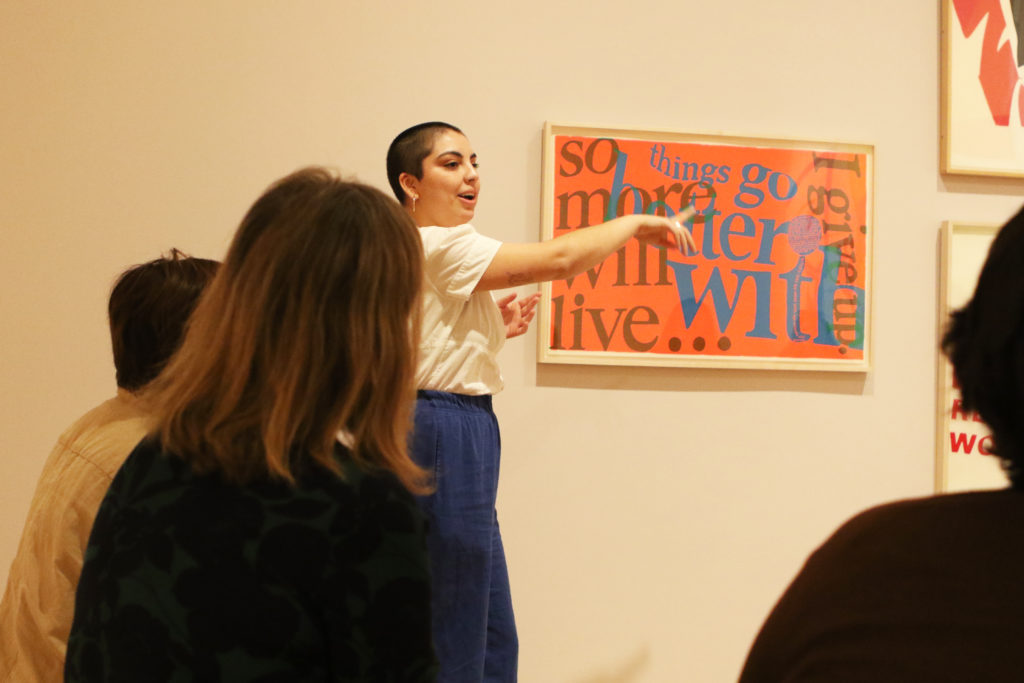At its most foundational level, VTS is about making meaning through group discussion, which requires that participants share a language with which to speak, listen, and understand one another. But what happens when the participants do not share a common language? Can the facilitator somehow take the place of a shared language, and if so, what does their facilitation look like? By leading bilingual VTS tours in the galleries of The Museum of Contemporary Art, Los Angeles (MOCA), I have practiced more inclusive discussions that support the communication and collaboration skills of all participants regardless of their familiarity with the dominant language. Bilingual VTS facilitation is a powerful tool for including English learner (EL) students, who often face exclusion and isolation in the classroom, in a way that affirms their existing skills and experiences.
In fall 2018, I prepared to give my first tour as an educator in Contemporary Art Start (CAS), MOCA’s classroom partnership program. CAS brings thousands of students from all over the Los Angeles area to the museum twice each school year for an hour-long tour led by educators like myself who use VTS to facilitate discussions about artworks on view. The program also provides year-long professional development to participating teachers who learn to implement VTS in their classrooms. Because it was my first tour ever, I team-taught with Jeanne Hoel, an experienced VTS facilitator who has led MOCA’s school and teacher programs for years. That morning, our team of educators greeted CAS teacher Mrs. Reyes and her students from Martin Luther King Jr. Elementary School. During that morning’s routine check-in, Mrs. Reyes let us know that four of her fourth grade students were English learners who typically participated in classroom VTS discussions in Spanish. Because I was the only Spanish-speaking educator touring, it was decided that Jeanne and I would take that group. As a new educator, I was just beginning to learn about VTS and felt particularly nervous about having to facilitate in Spanish.
As a Mexican immigrant, Spanish was the only language I spoke for the first few years of my life. At my pre-school in La Puente, California, I remember most of my classmates learning the letters of the alphabet while those of us who didn’t speak English played outside. Even though I enjoyed the unstructured time outdoors, I also recall feeling jealous and left out during these and other moments of exclusion. Not only had my dad taught me the alphabet already at home, but thanks to his teaching I had a love for reading and writing that my teacher, who rarely interacted with me, couldn’t have imagined. In kindergarten and first grade I began to learn English through my school’s English as a Second Language (ESL) program, which pulled me out of my classroom each day so I could meet with the ESL teacher and a handful of other English learners. By many measures, this model was successful: in second grade I was no longer in the ESL program and by third grade my English sounded like that of my classmates and I’d completely lost my accent.
Over time, my understanding of the English language improved but I slowly lost my native tongue. Due in part to the classist and xenophobic messages I received through my childhood, I internalized the belief that English was the superior language while Spanish was an embarrassing mark of difference. After learning English, my use of Spanish decreased drastically. A few years ago, I re-committed to studying and practicing Spanish independently after realizing how rusty it had gotten since my youth. Although today I speak it regularly with family and friends, I am self-conscious about my Spanish language skills at work, a setting that requires eloquence and professionalism. As a writer who learned and studied English formally through school, I feel confident in my ability to use this language to communicate. I learned Spanish, on the other hand, informally at home through my parents’ colloquial speech, which reflects a specific region and class. In Spanish, my vocabulary is mostly limited to the types of words I use day-to-day with my family, which doesn’t include words you might use to describe an artwork or discuss lofty concepts. Not only do I sometimes feel inadequate speaking or writing in Spanish in professional settings, but I always feel unequipped to do the added labor of translation despite the expectation of so many coworkers and supervisors over the years.
Despite these hesitations, when given the opportunity to teach Mrs. Reyes’s fourth grade students, I was excited for the opportunity to make every student feel included and heard, remembering my own exclusion as an English learner. Jeanne and I had only a couple of minutes to quickly coordinate before the tour began so I offered to translate her facilitation, assuming this to be the standard way of integrating EL students into a VTS discussion. During the tour, Jeanne asked VTS questions and paraphrased students’ comments in English while I translated her questions and paraphrases into Spanish. When a student shared in Spanish, I paraphrased in Spanish then translated my paraphrase into English for the rest of the group. It was difficult at first to find a steady rhythm since the double paraphrasing weighed the conversation down and required that Jeanne and I seamlessly and invisibly coordinate with one another.
Our efforts were immediately rewarded, however, as every student in the group, regardless of the language spoken, began to respond to and build on one another’s comments as though we were all speaking one language, able to understand and communicate with one another through our facilitation. The EL students, who were initially more quiet and reserved than their peers, contributed frequently and enthusiastically, sharing their personalities with us in the language of their thoughts. I was reminded that in my early classrooms I was considered a shy and quiet student, but among my Spanish-speaking cousins and neighbors I was loud, silly, and bossy. In school, I didn’t have a medium to share myself with my classmates and teachers; the personality that came across in my limited English was not mine, leaving me feeling unknown and invisible. As VTS facilitators, we frequently reflect on the social and emotional aspects of the practice, the community and rapport that can develop in group discussions about art and the opportunity to get to know our students holistically and organically. The bilingual tours I led throughout my time at MOCA reinforced these ideas while also making me aware of a need for more thoughtful and collective consideration of how to be inclusive of VTS participants whose primary language is not English.
In LAUSD, where over 150,000 students are English learners—more than in any other school district in the country—bilingual education and dual immersion programs are expanding, allowing more students to learn in their native language. In 2016, the California Multilingual Education Act was approved by 73.5% of voters, effectively repealing Proposition 227, which since 1999 had required that EL students be taught in English immersion programs only. Supporters of bilingual education like myself feel that these more inclusive models validate EL students’ native language and culture while supporting dual literacy and bilingualism. When I was learning English, I had no choice but to learn through an English-only program, which meant that I did not ever learn in Spanish in school and which contributed to my estrangement from the language. The illegality of bilingual programs in California schools under Proposition 227 sent the message that the only education worth pursuing was in English. I wonder what my relationship to Spanish, the only language I can use to connect with so many of my loved ones, would look like if I had not been shamed or discouraged from speaking it. I wonder how much less isolating it would have been in my early classrooms to share an idea out loud and have others listen, consider, and respond.
Over the last couple of tour seasons, I have taken on dozens of EL groups and made slight modifications to my tour format each time. The big question guiding my action research has been: how can the format of CAS tours best support English learners? Although the structure of the program reflects years of evaluation, reflection, and adjustment—core tenets of VTS—this level of refinement has not yet been applied to incorporating EL students. When you consider that LAUSD, which CAS primarily serves, has the largest EL population of any school district in the country, this is clearly a huge oversight. Bilingual tours are essential to the philosophies of CAS and VTS, both of which seek to be inclusive, collaborative, and learner-centered. Embracing language diversity is a necessary requirement for achieving these goals.
Because I myself learned English as an undocumented student in a California public school, I can greatly empathize with my EL students. Many of them are recent arrivals who, in the last couple of months or years, left their homes for a country steeped in hostility towards Black and brown immigrants. While classroom discussions alone cannot solve this historic and systemic violence, I believe that educators can refuse to perpetuate its dynamic in the classroom, creating environments that affirm our students’ humanity instead of fueling feelings of isolation and inferiority. Because bilingual VTS discussions contribute to inclusivity and community-building in the classroom, they can be powerful tools for knowing and empowering our EL students. Even when EL students become “proficient” in English, bilingual facilitation can affirm the fullness of our students’ identities and experiences and reject the assumption that some languages, cultures, and ways of being are more valuable than others.
A year later, Mrs. Reyes returned to MOCA with many of the EL students, now fifth graders, who had been on my first tour. Upon seeing me, many called my name and waved and some ran over to give me a hug. I began the tour, as I always do, saying in English and then in Spanish that participants are welcome to speak in whichever language they prefer and that I will be translating all comments for the benefit of the mixed-language group. Some EL students spoke in English, some in Spanish, and some switched between the two. Even bilingual students who were not designated “English learners” chose to participate in Spanish at times. After the tour, Mrs. Reyes pulled me aside to thank me and share her surprise at all of her students’ engagement. When she explained that two of her EL students never speak in class, we laughed because both students had taken plenty of airtime in that morning’s discussion, each sharing long-winded and thoughtful narratives about the artwork. Hearing Mrs. Reyes revise her understanding of these students out loud, I was honored to have facilitated an experience that allowed all of us to witness their excited and imaginative sides, creating space for their full selves in the classroom.
For more information on how to translate VTS questions into Spanish and what to consider when doing so, please see Raquel Rojas’s essay, “About Language.”

